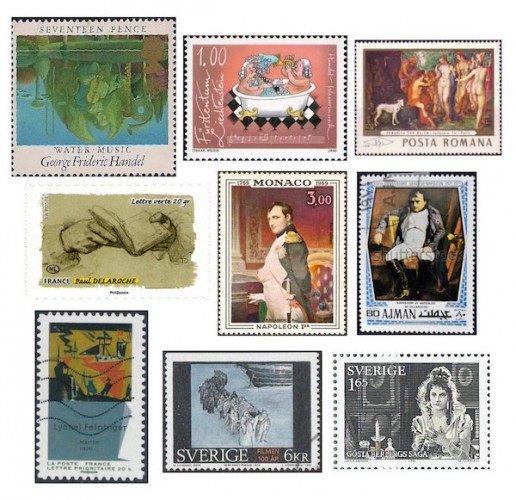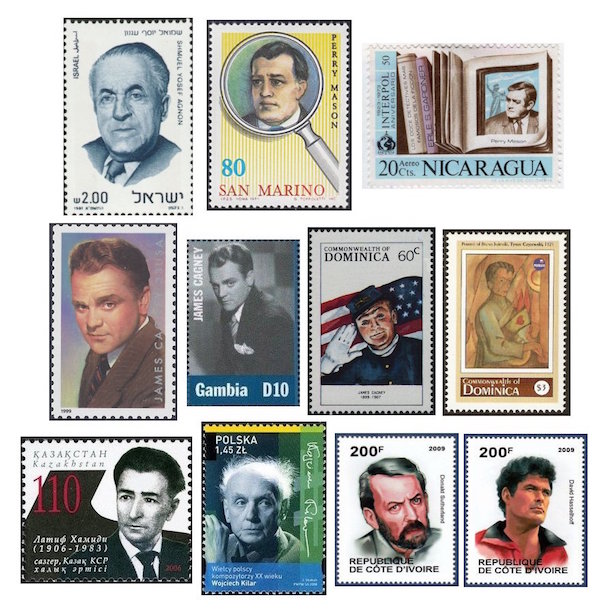The Arts on Stamps of the World — July 17
An Arts Fuse regular feature: the arts on stamps of the world.

By Doug Briscoe
Today is the 300th anniversary of the first performance of Handel’s Water Music, and there are two postage stamps that specifically cite the suites, one from Great Britain and one from Liechtenstein, both from sets commemorating famous music from the classical repertoire. Handel’s Water Music was first heard on a barge on the Thames on 17 July 1717, 300 years ago today. The music had been composed at the request of King George I, who, it seems, wanted to throw a big party as a PR move.
Flemish Baroque painter and stained glass designer Hendrick van Balen died on this date in 1632 in Antwerp, where he had been born, probably in 1573. His focus was on mythological and allegorical paintings, with a few religious ones. He collaborated with a number of artists, including Jan Brueghel the Elder and the Younger and Rubens, and among his many pupils was Anthony van Dyck. The only van Balen stamp I could find, a Romanian one, shows his undated Judgement of Paris.
French historical painter Paul Delaroche (17 July 1797 – 4 November 1856) was born into a Parisian family heavily involved in the art world as dealers, collectors, adminstrators, and even artists. Delaroche’s work retains elements of Academicism while exploring the emotional territory of Romanticism. He first exhibited at the Paris Salon in 1822 and achieved his greatest coup with The Execution of Lady Jane Grey (1833). He also painted portraits of Napoleon, as seen on stamps from Monaco and Ajman, the latter being Napoleon abdicating in Fontainebleau (1845). The new (2015) French stamp shows a drawing derived from his Charles I Insulted by Cromwell’s Soldiers (1837).

Our third consecutive painter is American Expressionist Lyonel Feininger (July 17, 1871 – January 13, 1956), who was born and reared in New York City but lived in his father’s homeland of Germany from the age of 16 until three years after Hitler came to power. He started as a cartoonist and was 36 before turning to fine art, thereafter becoming associated with the Blaue Reiter, Die Blaue Vier, and the Bauhaus. Around 1928 he began producing what would become a large body of photographic work, though this was not exhibited during his lifetime. Feininger, whose father had been a violinist and composer, also wrote some piano and organ pieces. The French stamp (Feininger studied in Paris and contributed drawings to French magazines in his youth) shows us his Marine (1924).
Perhaps the most famous accomplishment of Mauritz Stiller (17 July 1883 – 18 November 1928) is not the films he directed but rather the fact that he brought Garbo to America. He was born Moshe Stiller to a Jewish family living in Helsinki and was interested in acting from an early age, becoming involved with the budding film industry as a writer, actor, and director. He made many shorts as well as features, including the period drama Sir Arne’s Treasure (1919), cited on a Swedish stamp of 1995. Rather than find himself in the Tsar’s army, Stiller fled Russian-held Finland and took up Swedish residence, becoming a citizen in 1921. He discovered the teenaged Greta Garbo and cast her in The Saga of Gösta Berling (1924), as seen on the other Swedish stamp. Stiller directed a few pictures in Hollywood but returned to Sweden in 1927 and died there of pleurisy the next year, aged 45.
Israeli writer and Nobel Prize laureate Shmuel Yosef Agnon (July 17, 1888 – February 17, 1970) was born Shmuel Yosef Halevi Czaczkes and is known in Hebrew as Shai Agnon and in English as S. Y. Agnon. He was born in the Polish Galician part of Austria-Hungary and published his first poem, in Yiddish, when he was 15. At the age of 20 he relocated to Jaffa. He took the name Agnon from the title of the first story he published after his arrival, “Agunot” (“Forsaken Wives”). Five years later, though, he moved back to Europe, living in Berlin until he lost his books and manuscripts in a fire in 1924. Ironically, his next library was also destroyed, this time during anti-Jewish riots in Jerusalem in 1929. Agnon’s reputation as a writer was fixed with the publication of his novel Hachnasat Kalla (The Bridal Canopy, 1931). In 1966 he and Nelly Sachs shared the Nobel Prize in Literature.
A writer of a very different stripe was Erle Stanley Gardner (July 17, 1889 – March 11, 1970), who came from Malden but was graduated from high school in Palo Alto. He practiced law and sold his first story in 1923. Besides the 80-plus Perry Mason books, written between 1933 and 1973, he also wrote thirty books in the Cool and Lam detective series (one of which was only recently rediscovered and published for the first time last December). There are, in addition, a great many short stories, a dozen books of travel, mostly having to do with Baja California, and The Court of Last Resort, in which Gardner set out to right some of the wrongs of the criminal justice system by addressing specific cases of wrongly convicted defendants. Ironically, the only Edgar Ward he ever received was for this book. The stamps, both saluting crime writers and their protagonists and both obviously channeling Raymond Burr, come from San Marino and Nicaragua.

We have three North American movie actors in today’s lineup, first (and foremost) James Cagney (July 17, 1899 – March 30, 1986). He put in years on the stage as an actor and dancer before appearing in his first film in 1930. The very next year saw The Public Enemy, and Cagney was on his way. He won his only Oscar for his portrayal of George M. Cohan in 1942’s Yankee Doodle Dandy. He went into retirement after the non-stop Cold War comedy One, Two, Three (1961) (which would have exhausted anybody) and came out of retirement twenty years later for one last film, Ragtime (1981).
Polish futurist poet Bruno Jasieński (yah-SHEN-ski; 17 July 1901 – 17 September 1938) was one of the countless victims of the Stalinist purges, but his misfortune seems to have been a what-goes-around-comes-around situation. Born Wiktor Zysman to a Jewish doctor father and a Catholic mother of the Polish nobility, he was educated in Moscow but returned to newly reconstituted Poland after World War I. He came to the attention of the literary world as something of an enfant terrible in 1921. He and his first wife lived several years in Paris before he was deported for his radical writings. In Leningrad, the book that got Jasieński thrown out of France, I Burn Paris (1929), was reprinted and sold out in one day. A few years later he was vociferously supporting the purges instigated by NKVD director Genrikh Yagoda under Stalin’s imprimatur. It has been alleged that Jasieński was directly responsible for the persecution of Isaac Babel. When Yadoga fell out of favor in 1937 and went the way of his victims, Jasieński was left holding the proverbial bag. (His first wife, who had had an affair with Yadoga, was executed.) Expelled from the party, arrested, and sentenced to a fifteen-year prison term, Jasieński served only a matter of months before his own execution. (His second wife spent seventeen years in a gulag.) So perhaps it’s no surprise that there is no stamp directly honoring Bruno Jasieński; what we do have, though, is a portrait of the writer by Tytus Czyżewski (1880–1945). (And yes, the irony of juxtaposing die-hard commie Jasieński’s stamp next to Yankee Doodle Dandy is not lost on me.)
Composer Latif Khamidi (1906-1983) was a Tatar who chose to live in Kazakh, where he was named People’s Artist and awarded the State Prize of the Kazakh SSR. In collaboration with two other composers, Mukan Tulebayev and Yevgeny Brusilovsky, Khamidi wrote in 1945 the national anthem still used in Kazakhstan today (although to a new text). Perhaps his most important composition was the opera Abay (1944; again a collaborative effort, this time with Ahmet Zhubanov), written to commemorate the centenary of the Kazakh poet and philosopher Abay Qunanbayuli (1845-1904). Khamidi made many choral arrangements of Kazakh folk songs, which are also used in the opera.
The late Polish composer Wojciech Kilar (VOYT-s’yekh KEE-lahr; 1932 – 29 December 2013) wrote five symphonies, two piano concertos, and other orchestral, chamber, and vocal music, but is better known for his work in film. In addition to his scores for great Polish directors such as Krzysztof Kieślowski and Andrzej Wajda, he also provided the music for Francis Ford Coppola’s Dracula, for which he won the ASCAP Award in 1993, and The Pianist (César Award, 2003).
The other two actors born on July 17th, and also appearing on stamps of some kind, are Donald Sutherland (born 1935), who is Canadian, and David Hasselhoff (born 1952). Both of them appear in a big set of stamps from Côte d’Ivoire featuring popular current (mostly American) actors.
A graduate of the University of Massachusetts with a B.A. in English, Doug Briscoe worked in Boston classical music radio, at WCRB, WGBH, and WBUR, for about 25 years, beginning in 1977. He has the curious distinction of having succeeded Robert J. Lurtsema twice, first as host of WGBH’s weekday morning classical music program in 1993, then as host of the weekend program when Robert J.’s health failed in 2000. Doug also wrote liner notes for several of the late Gunther Schuller’s GM Recordings releases as well as program notes for the Boston Classical Orchestra. For the past few years he’s been posting a Facebook “blog” of classical music on stamps of the world, which has now been expanded to encompass all the arts for The Arts Fuse.

